Citroen NEMO RHD 2015 1.G Owner's Guide
Manufacturer: CITROEN, Model Year: 2015, Model line: NEMO RHD, Model: Citroen NEMO RHD 2015 1.GPages: 193, PDF Size: 8.3 MB
Page 21 of 193
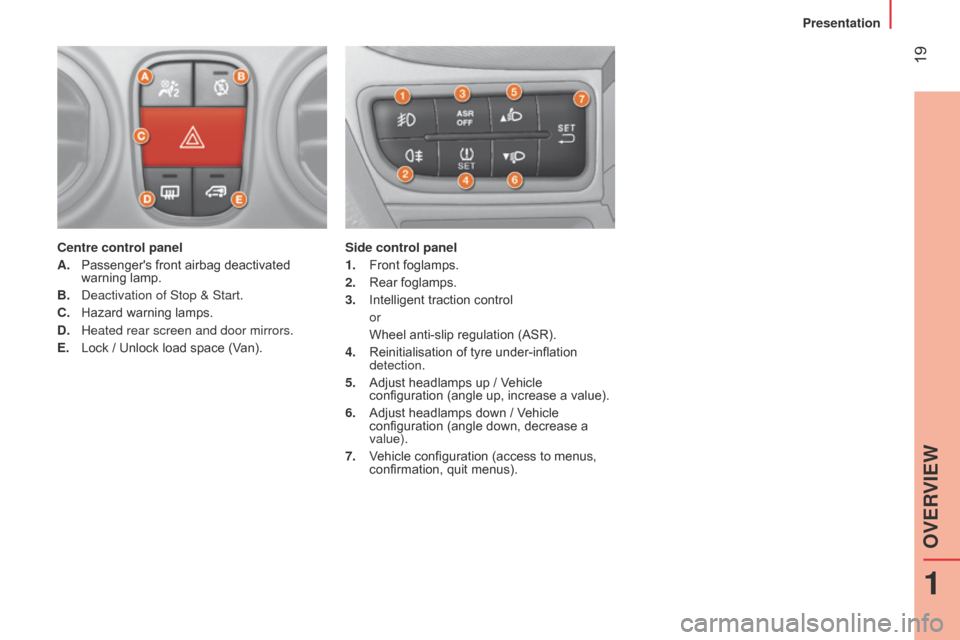
19
Centre control panel
A.
Passenger's front airbag deactivated
warning lamp.
B.
d eactivation of Stop & Start.
C.
Hazard warning lamps.
D.
Heated rear screen and door mirrors.
E.
Lock / Unlock load space (V
an).Side control panel
1.
Front foglamps.
2.
Rear foglamps.
3.
Intelligent traction control
or
Wheel anti-slip regulation (ASR).
4.
Reinitialisation of tyre under-inflation
detection.
5.
Adjust headlamps up / V
ehicle
configuration (angle up, increase a value).
6.
Adjust headlamps down / V
ehicle
configuration (angle down, decrease a
value).
7.
V
ehicle configuration (access to menus,
confirmation, quit menus).
1
OVERVIEW
Presentation
Page 22 of 193
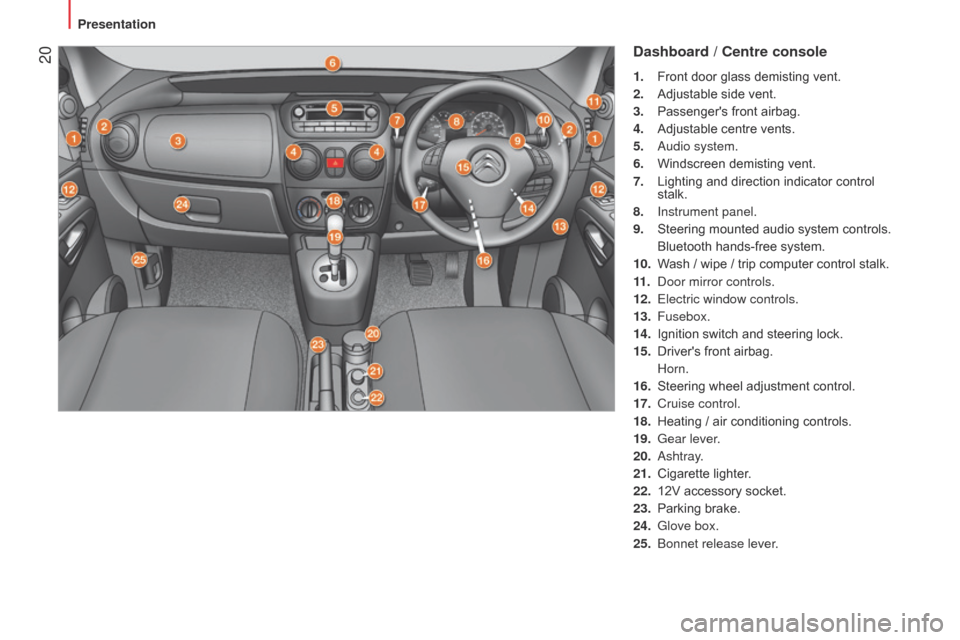
20Dashboard / Centre console
1. Front door glass demisting vent.
2.
Adjustable side vent.
3.
Passenger's front airbag.
4.
Adjustable centre vents.
5.
a udio system.
6.
Windscreen demisting vent.
7.
Lighting and direction indicator control
stalk.
8.
Instrument panel.
9.
Steering mounted audio system controls.
Bluetooth hands-free system.
10.
W
ash / wipe / trip computer control stalk.
11 .
d oor mirror controls.
12.
Electric window controls.
13.
Fusebox.
14.
Ignition switch and steering lock.
15.
Driver's front airbag.
Horn.
16.
Steering wheel adjustment control.
17.
Cruise control.
18.
Heating / air conditioning controls.
19.
Gear lever
.
20.
a shtray.
21.
Cigarette lighter
.
22.
12V accessory socket.
23.
Parking brake.
24.
Glove box.
25.
b onnet release lever.
Presentation
Page 23 of 193
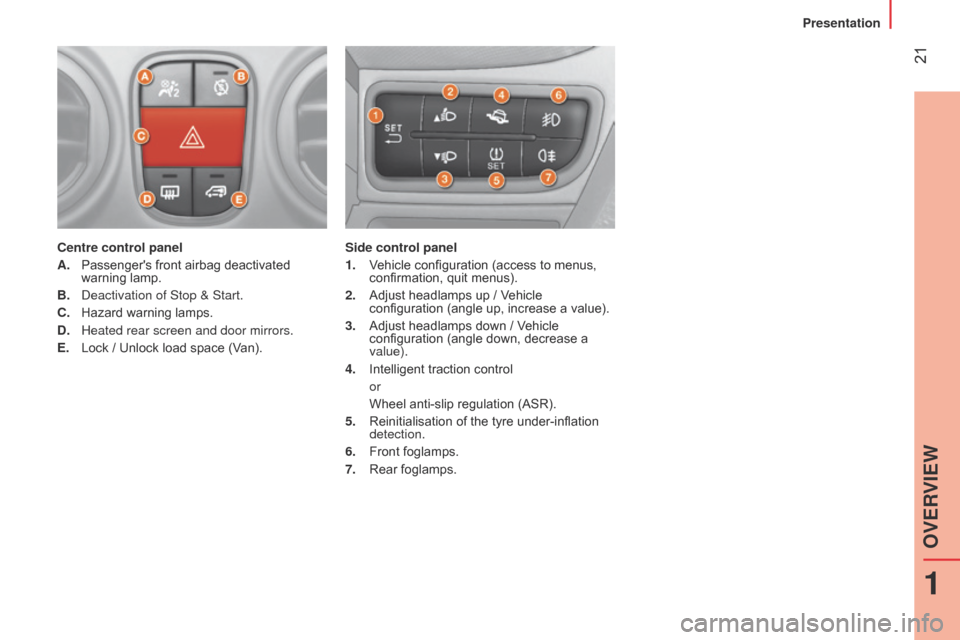
21
Centre control panel
A.
Passenger's front airbag deactivated
warning lamp.
B.
d eactivation of Stop & Start.
C.
Hazard warning lamps.
D.
Heated rear screen and door mirrors.
E.
Lock / Unlock load space (V
an).Side control panel
1.
V
ehicle configuration (access to menus,
confirmation, quit menus).
2.
Adjust headlamps up / V
ehicle
configuration (angle up, increase a value).
3.
Adjust headlamps down / V
ehicle
configuration (angle down, decrease a
value).
4.
Intelligent traction control
or
Wheel anti-slip regulation (ASR).
5.
Reinitialisation of the tyre under-inflation
detection.
6.
Front foglamps.
7.
Rear foglamps.
1
OVERVIEW
Presentation
Page 24 of 193

22
ENVIRONMENT
With you, CITRoËn acts to protect the
environment.
W
e invite you to visit the www.citroen.co.uk
website.a s the driver, you also can contribute to
protecting the environment by following certain
rules: Refer to information on eco-driving at the
end of this section.
-
adopt a preventive style of driving, without
frequent and harsh acceleration,
-
observe the service intervals; we
recommend that services are carried
out by a CITR
o Ë n dealer, authorised to
collect used batteries and fluids,
-
in order to preserve the reliability of the
engine and emission control systems, do
not use engine oil additives.
Motoring & Environment
Page 25 of 193
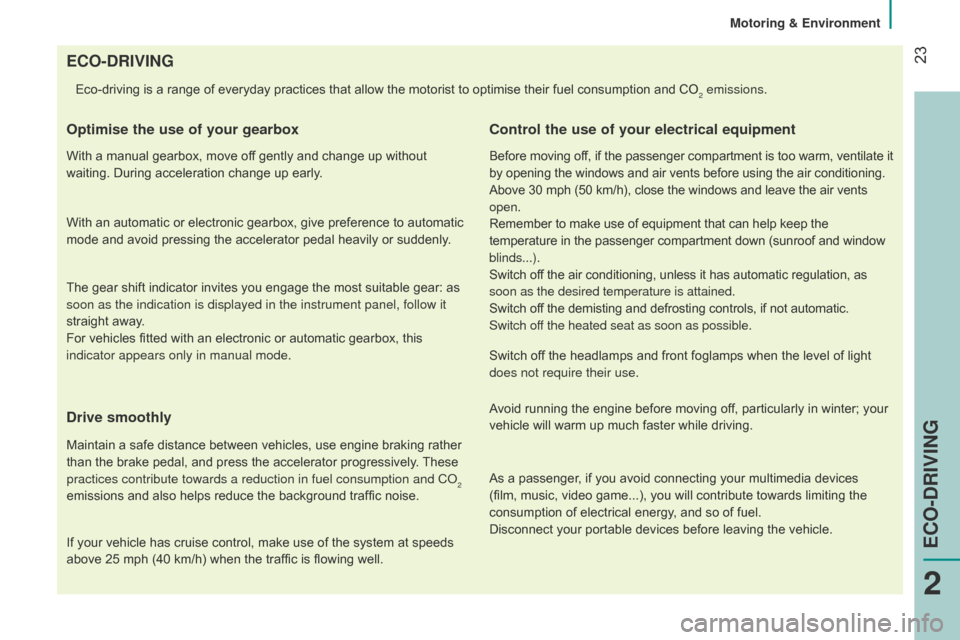
23ECO-DRIVING
Eco-driving is a range of everyday practices that allow the motorist to optimise their fuel consumption and CO2 emissions.
Optimise the use of your gearbox
With a manual gearbox, move off gently and change up without
waiting. During acceleration change up early.
With an automatic or electronic gearbox, give preference to automatic
mode and avoid pressing the accelerator pedal heavily or suddenly.
The gear shift indicator invites you engage the most suitable gear: as
soon as the indication is displayed in the instrument panel, follow it
straight away.
For vehicles fitted with an electronic or automatic gearbox, this
indicator appears only in manual mode.
Drive smoothly
Maintain a safe distance between vehicles, use engine braking rather
than the brake pedal, and press the accelerator progressively. These
practices contribute towards a reduction in fuel consumption and C o
2
emissions and also helps reduce the background traffic noise.
If your vehicle has cruise control, make use of the system at speeds
above 25 mph (40 km/h) when the traffic is flowing well.
Control the use of your electrical equipment
Before moving off, if the passenger compartment is too warm, ventilate it
by opening the windows and air vents before using the air conditioning.
Above 30 mph (50 km/h), close the windows and leave the air vents
open.
Remember to make use of equipment that can help keep the
temperature in the passenger compartment down (sunroof and window
blinds...).
Switch off the air conditioning, unless it has automatic regulation, as
soon as the desired temperature is attained.
Switch off the demisting and defrosting controls, if not automatic.
Switch off the heated seat as soon as possible.
Switch off the headlamps and front foglamps when the level of light
does not require their use.
Avoid running the engine before moving off, particularly in winter; your
vehicle will warm up much faster while driving.
As a passenger, if you avoid connecting your multimedia devices
(film, music, video game...), you will contribute towards limiting the
consumption of electrical energy, and so of fuel.
Disconnect your portable devices before leaving the vehicle.
2
ECO-DRIVING
Motoring & Environment
Page 26 of 193
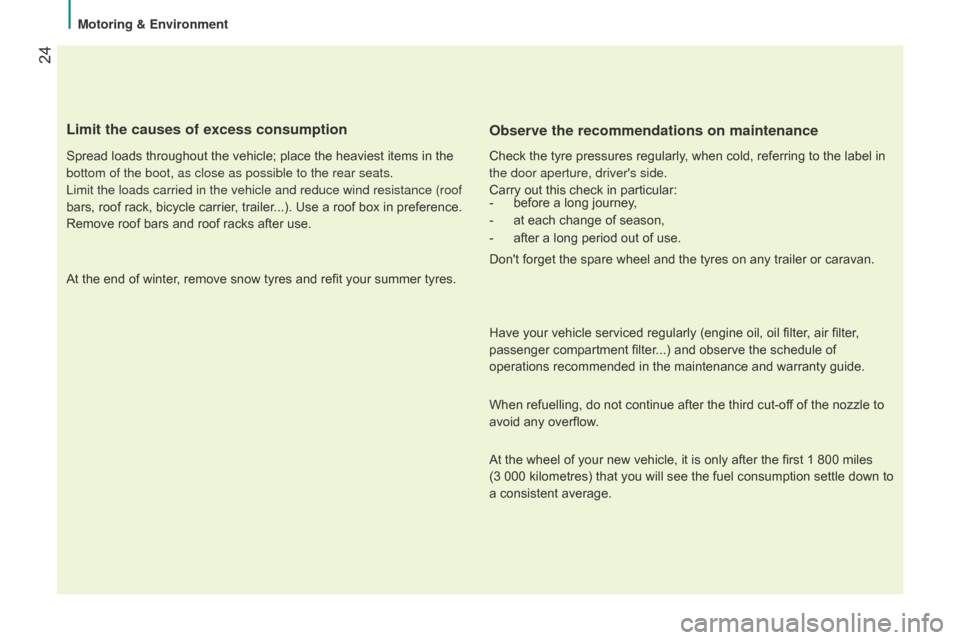
24
Limit the causes of excess consumption
Spread loads throughout the vehicle; place the heaviest items in the
bottom of the boot, as close as possible to the rear seats.
Limit the loads carried in the vehicle and reduce wind resistance (roof\
bars, roof rack, bicycle carrier, trailer...). Use a roof box in preference.
Remove roof bars and roof racks after use.
At the end of winter, remove snow tyres and refit your summer tyres.
Observe the recommendations on maintenance
Check the tyre pressures regularly, when cold, referring to the label in
the door aperture, driver's side.
Carry out this check in particular:
-
before a long journey
,
-
at each change of season,
-
after a long period out of use.
Don't forget the spare wheel and the tyres on any trailer or caravan.
Have your vehicle serviced regularly (engine oil, oil filter
, air filter,
passenger compartment filter...) and observe the schedule of
operations recommended in the maintenance and warranty guide.
When refuelling, do not continue after the third cut-off of the nozzle to
avoid any overflow.
At the wheel of your new vehicle, it is only after the first 1 800 miles
(3 000 kilometres) that you will see the fuel consumption settle down to
a consistent average.
Motoring & Environment
Page 27 of 193
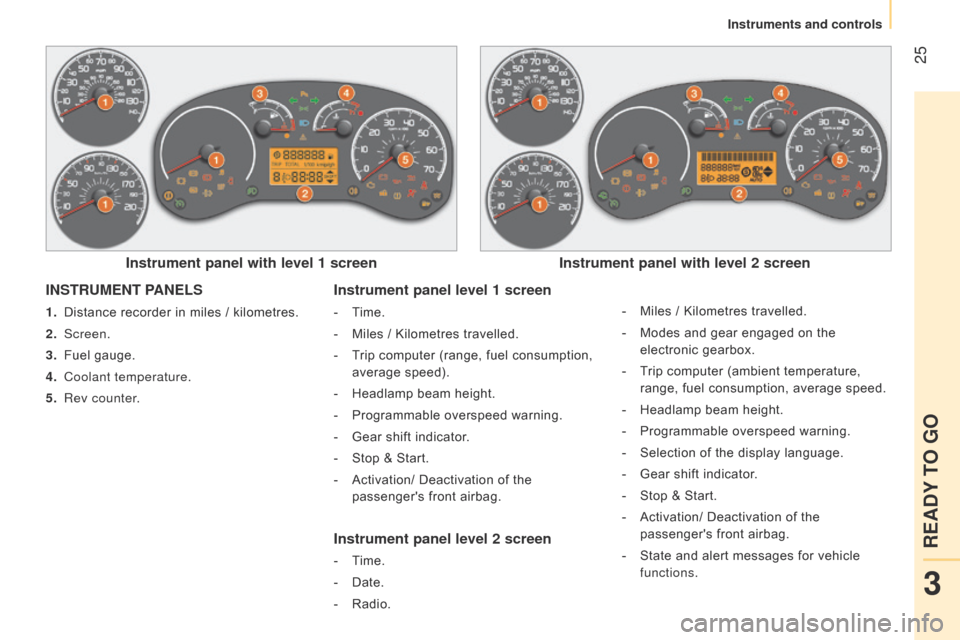
25
INSTRUMENT PANELS
1. Distance recorder in miles / kilometres.
2. Screen.
3.
Fuel gauge.
4.
Coolant temperature.
5.
Rev counter
.
Instrument panel with level 1 screen Instrument panel with level 2 screen
Instrument panel level 1 screen
- Time.
-
Miles / Kilometres travelled.
-
T
rip computer (range, fuel consumption,
average speed).
-
Headlamp beam height.
-
Programmable overspeed warning.
-
Gear shift indicator
.
-
Stop & Start.
-
Activation/ Deactivation of the
passenger's front airbag.
Instrument panel level 2 screen
- Time.
-
Date.
-
Radio. -
Miles / Kilometres travelled.
-
Modes and gear engaged on the
electronic gearbox.
-
T
rip computer (ambient temperature,
range, fuel consumption, average speed.
-
Headlamp beam height.
-
Programmable overspeed warning.
-
Selection of the display language.
-
Gear shift indicator
.
-
Stop & Start.
-
Activation/ Deactivation of the
passenger's front airbag.
- State and alert messages for vehicle
functions.
3
READY TO GO
Instruments and controls
Page 28 of 193
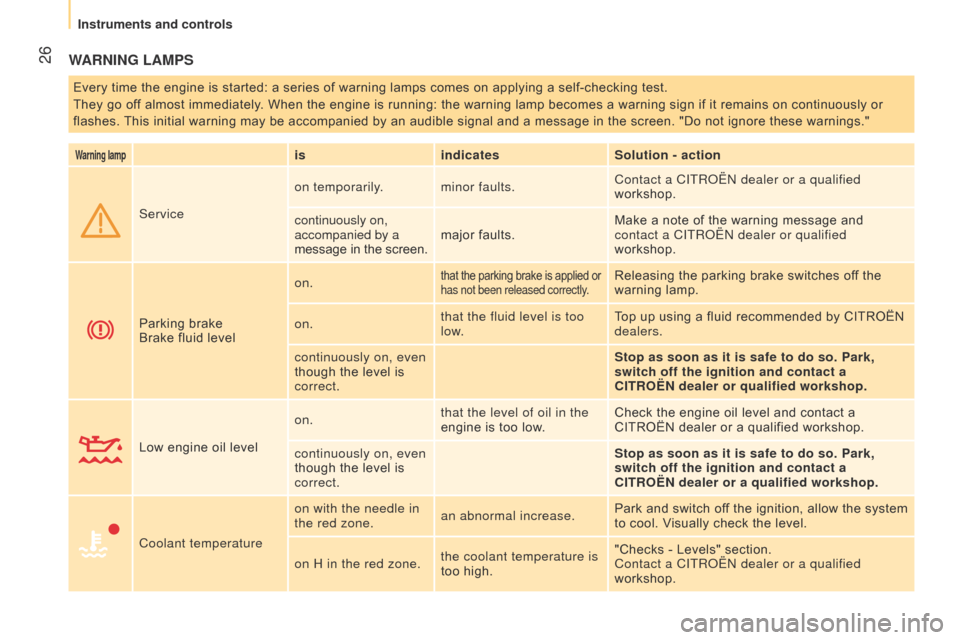
26WARNING LAMPS
Every time the engine is started: a series of warning lamps comes on applying a self-checking test.
They go off almost immediately. When the engine is running: the warning lamp becomes a warning sign if it remains on continuously or
flashes. This initial warning may be accompanied by an audible signal and a message in the screen. "Do not ignore these warnings."
Warning lampisindicates Solution - action
Service on temporarily. minor faults.
Contact a CITR
o Ë n dealer or a qualified
workshop.
continuously on,
accompanied by a
message in the screen. major faults. Make a note of the warning message and
contact a CITR
o Ë n dealer or qualified
workshop.
Parking brake
Brake fluid level on.
that the parking brake is applied or
has not been released correctly.Releasing the parking brake switches off the
warning lamp.
on. that the fluid level is too
low. Top up using a fluid recommended by CITROËN
dealers.
continuously on, even
though the level is
correct. Stop as soon as it is safe to do so. Park,
switch off the ignition and contact a
CITROËN dealer or qualified workshop.
Low engine oil level on.
that the level of oil in the
engine is too low. Check the engine oil level and contact a
CITROËN dealer or a qualified workshop.
continuously on, even
though the level is
correct. Stop as soon as it is safe to do so. Park,
switch off the ignition and contact a
CITROËN dealer or a qualified workshop.
Coolant temperature on with the needle in
the red zone.
an abnormal increase. Park and switch off the ignition, allow the system
to cool. Visually check the level.
on H in the red zone. the coolant temperature is
too high. "Checks - Levels" section.
Contact a CITR
o Ë n dealer or a qualified
workshop.
Instruments and controls
Page 29 of 193

27
Warning lampisindicates Solution - action
Engine oil on while driving, with
a message in the
screen.
that the engine oil
pressure is too low.
Park and switch off the ignition and contact a
CITROËN dealer or a qualified workshop.
flashing, with a
message in the
screen (1.3 HDi 75
only). deteriorated engine oil.
Have the vehicle services as soon as possible to
avoid damage to the engine.
Battery charge on.
a fault in the charging
circuit. Check the battery terminals…
"Quick help - Battery" section.
continuously on, in
spite of the checks. an ignition or injection
fault. Contact a CITR
o Ë n dealer or a qualified
workshop.
d
oor open detection on.
that a door is not closed
correctly. Check that the front, rear and side doors are
closed.
accompanied by a
message in the screen.
Seat belt not fastened on then flashes.
that the driver has not
fastened his seat belt. Pull the strap then insert the tongue in the
buckle.
accompanied by an
audible signal then
remains on. that the vehicle is moving
with the driver's seat belt
unfastened. Check that the seat belt is fastened correctly by
pulling the strap.
"Safety - Seat belts" section.
flashing,
accompanied by an
audible signal the front passenger has
not fastened their seat
belt.
Pull on the strap and insert the tongue in the
buckle.
3
READY TO GO
Instruments and controls
Page 30 of 193
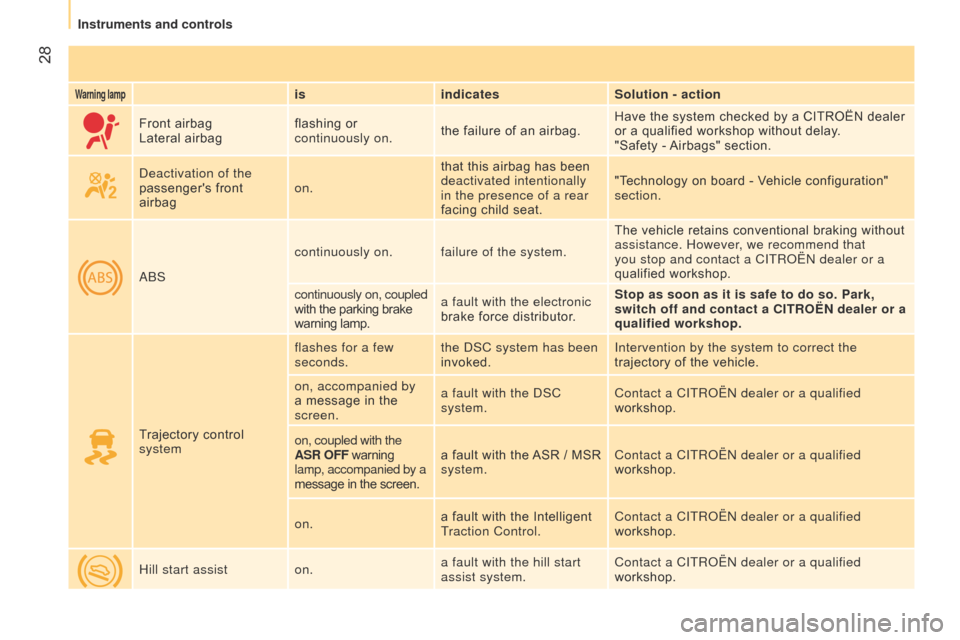
28
Warning lampisindicates Solution - action
Front airbag
Lateral airbag flashing or
continuously on.
the failure of an airbag. Have the system checked by a CITROËN dealer
or a qualified workshop without delay.
"Safety - Airbags" section.
d
eactivation of the
passenger's front
airbag on.that this airbag has been
deactivated intentionally
in the presence of a rear
facing child seat. "Technology on board - Vehicle configuration"
section.
ab
S continuously on. failure of the system.
The vehicle retains conventional braking without
assistance. However, we recommend that
you stop and contact a CITR
o Ë n dealer or a
qualified workshop.
continuously on, coupled
with the parking brake
warning lamp. a fault with the electronic
brake force distributor. Stop as soon as it is safe to do so. Park,
switch off and contact a
CITROËN dealer or a
qualified workshop.
Trajectory control
system flashes for a few
seconds.
the
d SC system has been
invoked. Intervention by the system to correct the
trajectory of the vehicle.
on, accompanied by
a message in the
screen. a fault with the
d SC
system. Contact a CITR
o Ë n dealer or a qualified
workshop.
on, coupled with the
ASR OFF warning
lamp, accompanied by a
message in the screen. a fault with the ASR / MSR
system.
Contact a CITR
o Ë n dealer or a qualified
workshop.
on. a fault with the Intelligent
Traction Control. Contact a CITR
o Ë n dealer or a qualified
workshop.
Hill start assist on.a fault with the hill start
assist system. Contact a CITR
o Ë n dealer or a qualified
workshop.
Instruments and controls